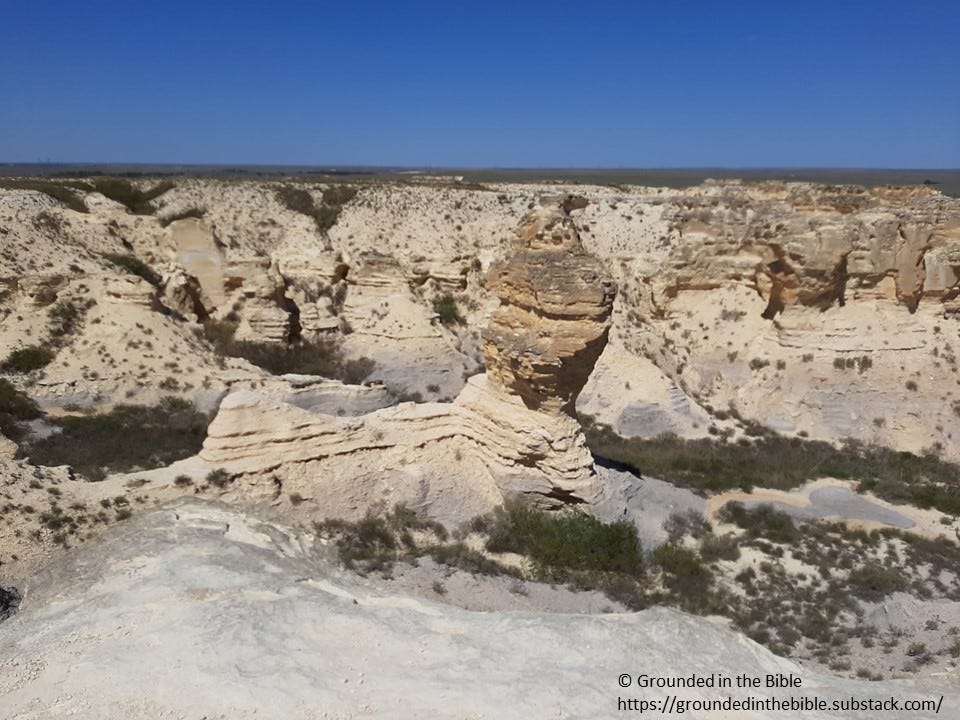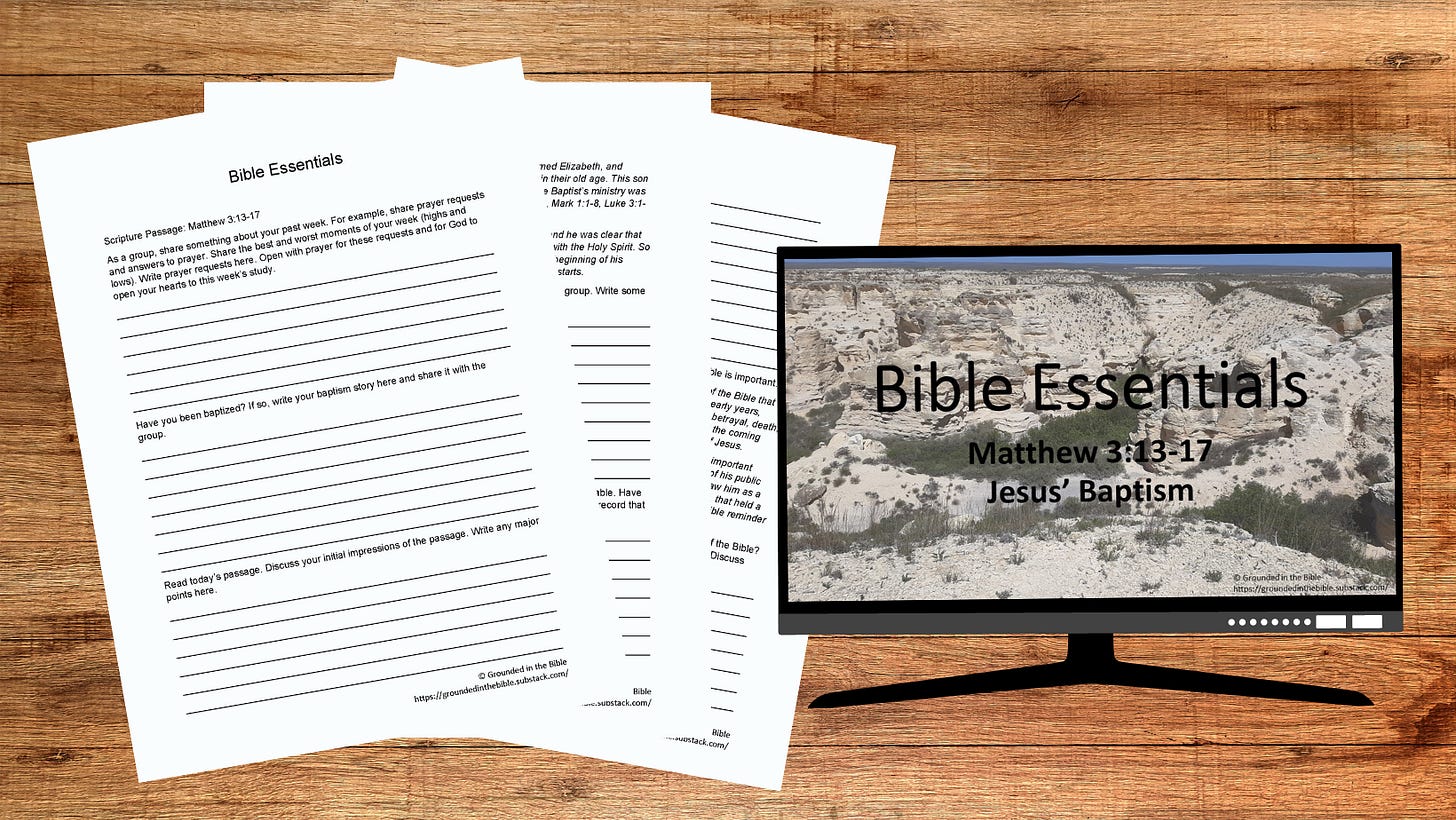Opening
Individuals: Take time to think back about your past week. Where have you seen God work in your life or answer prayer? Write down any prayer requests you have.
Group: Open the study by sharing life updates, reviewing highs and lows of your past week, or sharing prayer requests and praises.
*NEW* Icebreaker: Have you been baptized? If so, share your baptism story with the group
All: Begin the study with a word of prayer, asking God to open your heart for today’s study. You can also pray for any prayer requests now, or save that for the end.
Study
Read today’s passage: Matthew 3:13-17.
13 Then Jesus came from Galilee to the Jordan to be baptized by John. 14 But John tried to deter him, saying, “I need to be baptized by you, and do you come to me?”
15 Jesus replied, “Let it be so now; it is proper for us to do this to fulfill all righteousness.” Then John consented.
16 As soon as Jesus was baptized, he went up out of the water. At that moment heaven was opened, and he saw the Spirit of God descending like a dove and alighting on him. 17 And a voice from heaven said, “This is my Son, whom I love; with him I am well pleased.”
What is the context for this passage?
We learn in Luke 1 that Mary (Jesus’ mother) has a relative named Elizabeth, and Elizabeth and her husband Zechariah were blessed with a son in their old age. This son would be named John, later known as John the Baptist. John the Baptist’s ministry was to preach about the coming of Jesus, as seen in Matthew 3:1-12, Mark 1:1-8, Luke 3:1-20, and John 1:19-34.
John preached a message of repentance and baptism by water, and he was clear that another person (Jesus) would come after him who would baptize with the Holy Spirit. So it seems only fitting that when Jesus wanted to be baptized at the beginning of his ministry, he would come to John. This is where our passage today starts.
Read the passage again.
Explore a different version if you have one available. If you are online, here is a link to Matthew 3 in NIV through Bible Gateway. You can change the version by using the dropdown menu at the top right of the page.
Try to summarize the passage in your own words.
Answer these three questions about the passage:
1. What does the passage say about God?
God is Trinity. This is one of the most important things we learn from this passage. We clearly see all three parts of the Trinity: Father (voice from heaven), Son (Jesus), and Holy Spirit (descends like a dove). The Trinity is one of the most complex concepts in the Bible for our minds to understand, and the word “Trinity” is never actually used in the Bible. But the teaching of God as three-in-one is clearly evident here.
Jesus felt it was important to be baptized. John taught a baptism by water for repentance. Although Jesus had no sin, and thus no need for repentance, he still felt that the symbolism of the water baptism was important. I’ve heard people ask why is it important to be baptized. I won’t get into all that here (although I hope to do a lesson on baptism eventually), but in my mind, if Jesus thought it was important for him, it’s important for us too.
Jesus understands the importance of fulfilling righteousness. What does it mean to “fulfill all righteousness”? We usually use the term “fulfill” when talking about prophecy. When Jesus came to earth, he fulfilled the prophecies in the Old Testament. Is that the same as fulfilling righteousness? That’s one possibility.
Here’s another idea. God is the only one who is righteous. In order for all people to be redeemed and to be seen by God as righteous, God requires a perfect sacrifice. Jesus was that sacrifice. And by being baptized here, Jesus is committing to his mission—he is committing to being the one sacrifice for sin so that all people can be made righteous in God’s sight. This event is like a blessing from God the Father on Jesus’ mission—by receiving the Holy Spirit, Jesus has all the tools and support he needs to complete the mission.
The Spirit is represented as a dove. In the Bible, a dove could carry many meanings. We first see doves in Genesis 8, when Noah sends the dove out after the flood. The dove brings back a symbol that the floodwaters are receding and it will soon be safe for Noah and his family to leave the ark. It was a sign that God had not forgotten his people. We also see doves mentioned throughout Leviticus, particularly as an animal that can be used as a sin offering (see Leviticus 5). So perhaps this is fitting since Jesus was going to become the sacrifice for our sins.
God resides in heaven. We saw this in our study of Jesus’ birth in Luke 2 as well. Heaven is the dwelling place of God, and occasionally, he opens heaven to interact with the people on earth. This is one of those times.
God is pleased with and loves his Son. This is a clear statement from God: “This is my Son, whom I love; with him I am well pleased.” This is affirmation that Jesus is God’s Son and that Jesus’ actions to this point have been exactly what they need to be to fulfill his purpose on earth.
2. What does the passage say about people?
People who recognize Jesus as the Messiah are humbled in his presence. John the Baptist clearly recognized that Jesus was the Messiah. We see this especially in the parallel passage in John 1:32-34. This is also evident in the way John responded to Jesus’ request to be baptized: “I [John] need to be baptized by you [Jesus], and do you come to me?” John responded in humbleness, knowing that Jesus’ ministry would far surpass his own and that Jesus was the one who truly had the power to save people.
3. What does the passage say about God’s plan?
God’s plan was to give Jesus his blessing for ministry. The reason that Jesus was sent to earth was to do ministry that would eventually lead to the cross, where he would pay the ultimate price for all sins. The Spirit alighting on Jesus and the voice from heaven are both ways that God anointed Jesus for his ministry going forward. God basically put his stamp of approval on the plan.
God’s plan was for Jesus and the Holy Spirit to work together on earth. Jesus’ ministry was marked with many instances of Jesus performing miracles and teaching through the power of the Holy Spirit. It is through this partnership that Jesus’ ministry was effective.
How does the passage fit into the overarching story of the Bible?
Sometimes it’s easier to understand a passage if you have a little outside knowledge from other passages in the Bible. This section will help provide that outside perspective.
The four gospels (Matthew, Mark, Luke, John) are the primary books of the Bible that tell us about Jesus’ time on earth. These books chronicle Jesus’ birth, early years, baptism by John, temptation in the wilderness, miracles and teachings, betrayal, death, and resurrection. Through these books, we see many prophecies about the coming Messiah from the Old Testament be fulfilled through the life and death of Jesus.
The inclusion of the story of Jesus’ baptism in this history of Jesus’ life is important because it clarifies Jesus’ relationship to God and it marks the beginning of his public ministry. People at the time had a lot of respect for John the Baptist and saw him as a prophet, so when John identified Jesus as the one that he preached about, that held a lot of weight with the people of the time. Jesus’ baptism also provides a visible reminder that the Holy Spirit was with Jesus during his ministry.
Discussion
Individual: Answer the following questions thoughtfully for yourself.
Group: Pose these questions for discussion.
All: If you are willing to share, I’d love to hear your thoughts to these questions. Feel free to use the comment section to start a discussion about this passage.
What else strikes you about this passage?
How does the passage affect how you view God? How you view yourself?
How does this passage affect how you will live your life?
Additional Study
For additional study related to this topic, read parallel versions in Mark 1:9-11, Luke 3:21-38, and John 1:29-34.
Premium Resources
For Bible Essential studies, you can use my thoughts as your devotional, or you can download and use the journaling sheet to work through the passage on your own. If desired, you can then compare your thoughts to mine. Journal sheets can be downloaded and used now or later. They can be printed and filled in by hand or saved and filled out electronically. Journal sheets are available for individual or group use.
If you plan to lead a group study, a PowerPoint presentation is also available.
You can access these resources by clicking here: Matthew 3 Resources




